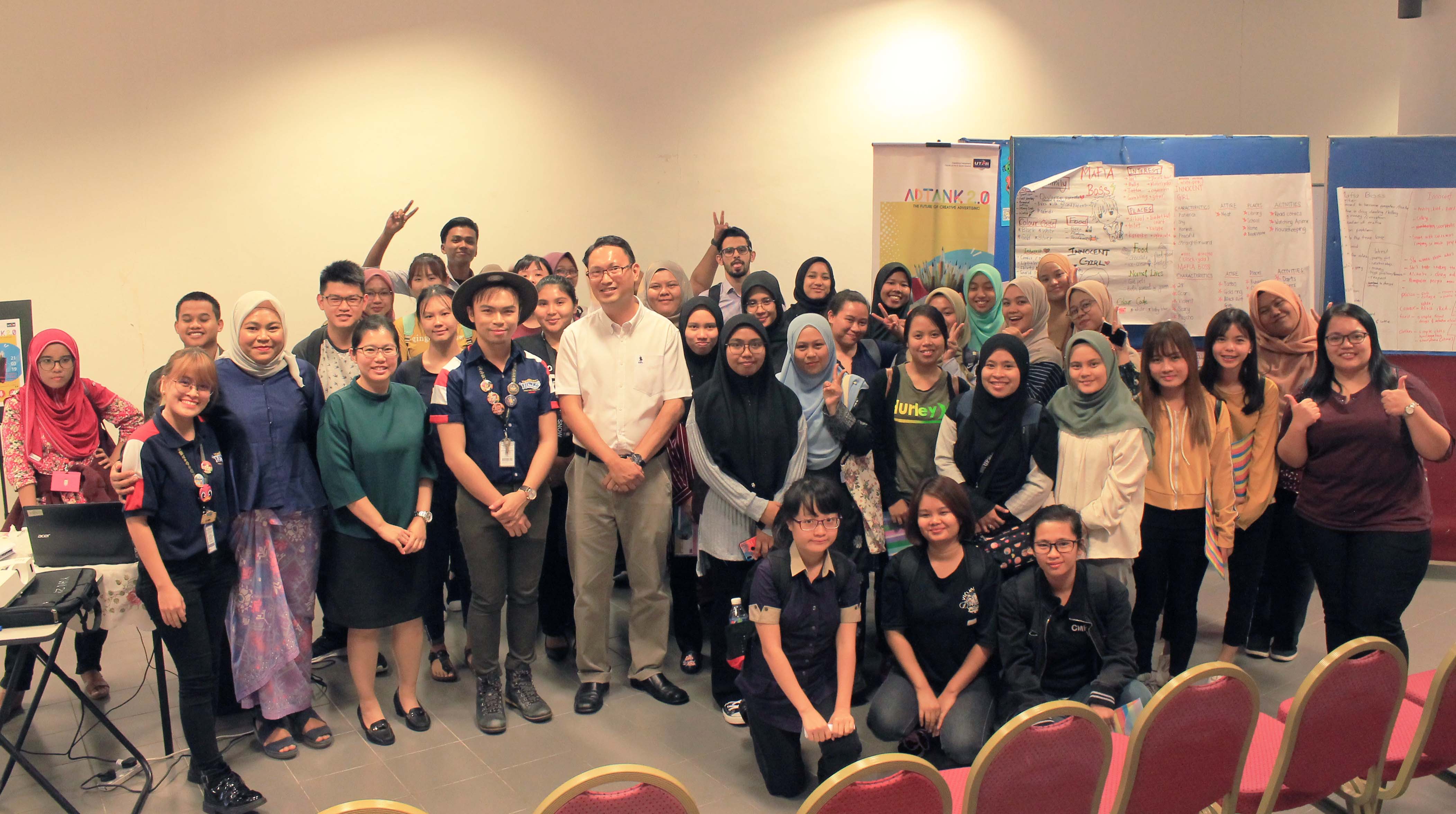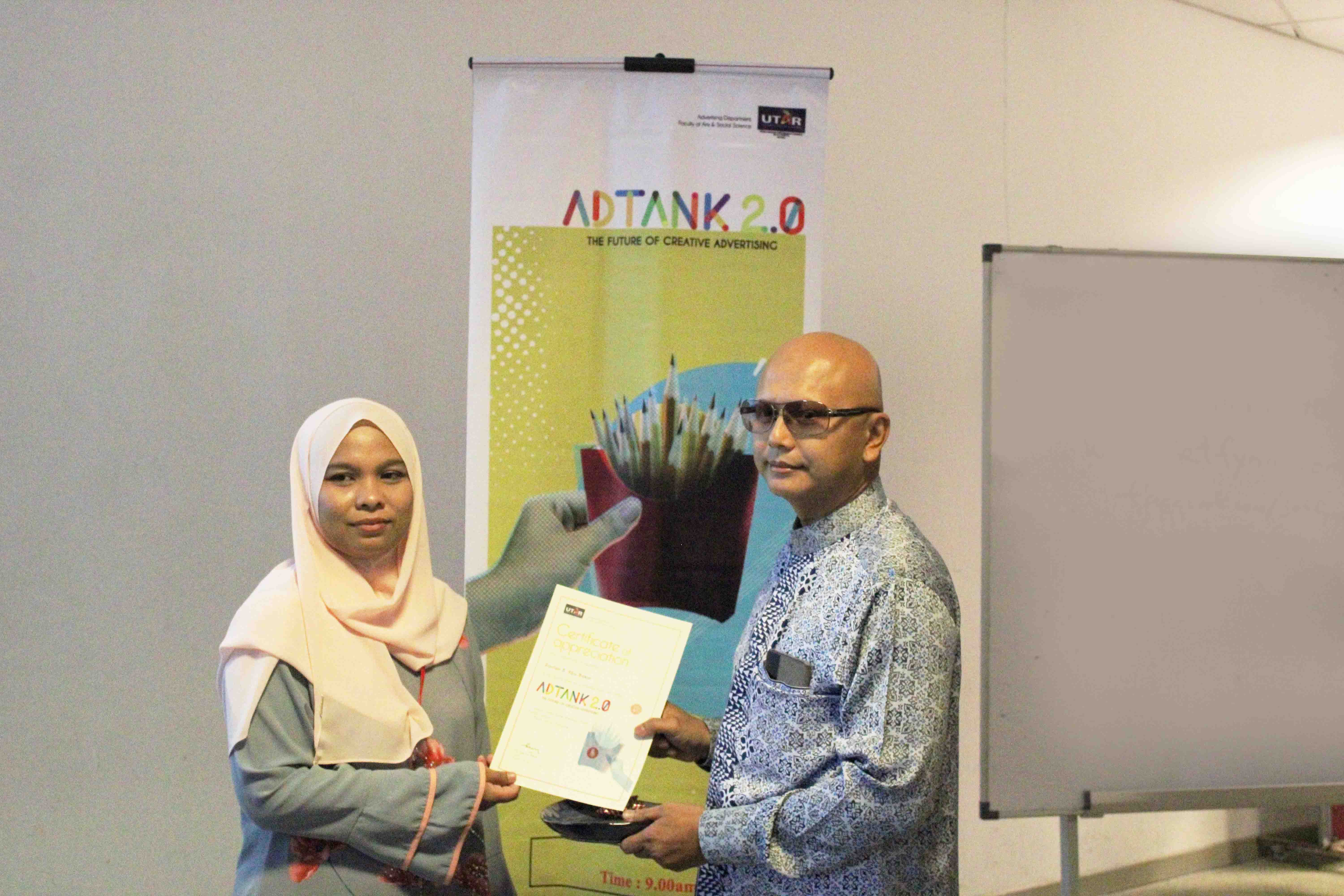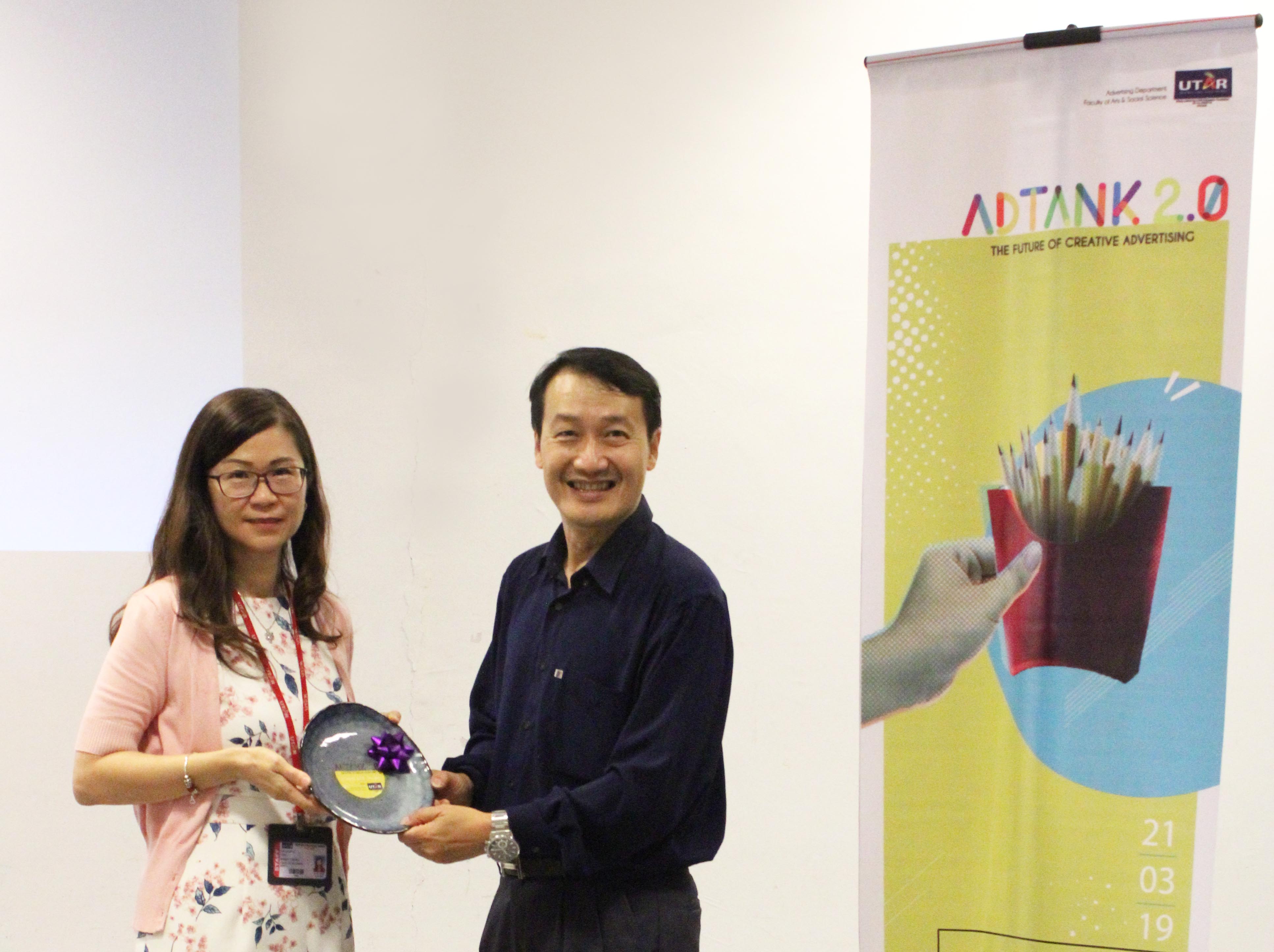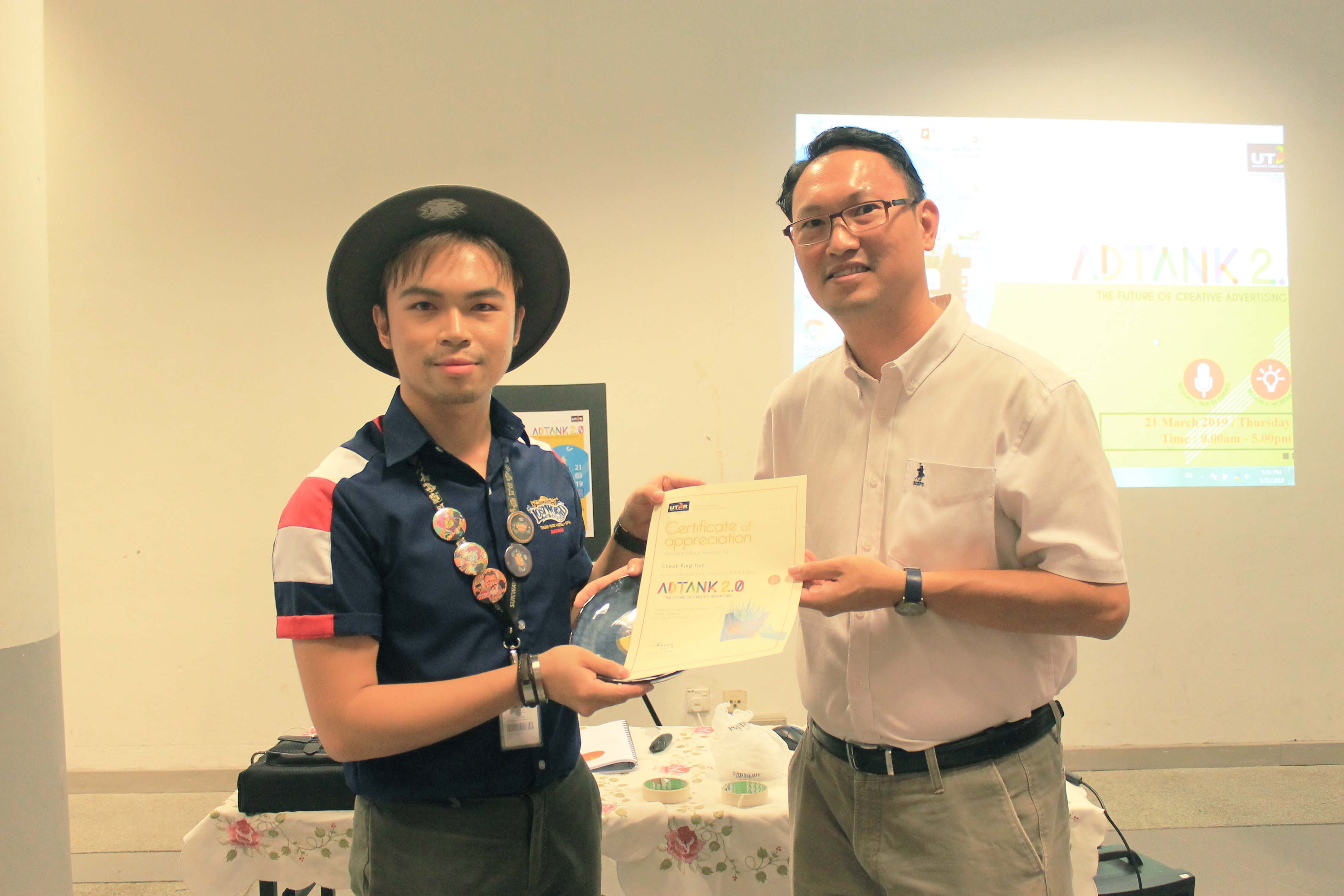


Dr Khor (centre in white) with speakers and participants after the event
The ADTank 2.0 was organised by the Department of Advertising of Faculty of Arts and Social Science (FAS) on 21 March 2018 at UTAR Kampar Campus.
Present at the event were FAS Dean Dr Lee Lai Meng, FAS Deputy Dean for Academic Development and Undergraduate Programmes Dr Khor Kheng Kia, and speakers Akademi Seni Budaya dan Warisan Kebangsaan (ASWARA) Academic Muhammad Rasfan Haji Abu Bakar, Ong Min Ho from Jet Fynn Photography and Cheah King Tjun from Lost World of Tambun, along with students and staff.
ADTank 2.0 combined talks and workshop that integrated multiple university students in developing knowledge of the creative industry. The programme aimed to create synergy between different institutions and provide a framework that will increase participants’ abilities in planning, problem-solving and decision-making within the creative industry.
Additional objectives of ADTank 2.0 also included cultivating awareness of future creative advertising in students, exposing students to new age advertising trends and developing students’ keen and active minds, and forming ideas with complete execution. It also provided participants with concepts and technical proficiency of photography as a tool in advertising and practicing principles in creative strategy and persuasive marketing. ADTank 2.0 also demonstrated strategic research and planning in advertising, taught participants on managing projects from concept to completion using tools from the industry and developed participants’ creative problem-solving skills by presenting to them the challenges of advertising and marketing communication.
“The first ADTank started last year (2018). It was done on a smaller scale with only 30 participants. This year ADTank 2.0 was very successful and we attracted over 60 participants from three institutions, including UTAR. I am pleased to see more participation this year, and it is also a good encouragement for our organising committee to continue their effort in creating a platform that provides participants with important industrial knowledge. From the speakers to the talks and workshop, I hope you will use these activities as opportunities to enhance your advertising skills. In order to be successful in the creative industry, you must be a good problem solver; and to be a good problem solver, you must be able to analyse the problem from various perspectives. It is important that you equip yourself with sufficient fundamental knowledge to be able to conduct relevant research to solve a specific problem,” said Dr Khor in his opening speech.
He added, “In the advent of the Fourth Industrial Revolution, the creative industry has become more competitive and challenging, hence it is important for all academics and students to learn about the latest trends, skills, methods and technologies used in this industry. Therefore, take this opportunity to expand your horizon. I hope you will also take a bold step and interact with the speakers and participants. Don’t be afraid to ask questions and learn everything you can on what it takes to be successful in the creative industry.”
While Muhammad Rasfan showcased some of his photographic work, Ong on the other hand, spoke about photography in advertising. He shared the history of photography and mentioned that his passion for photography began in 1980. He started by taking simple photographs and then taking on bigger projects such as wedding shoots. From there, his career as a photographer kick-started and led to Ong establishing his current business, Jet Fynn Photography.
“Photography is all about perception. If you actually study the history of photography, the concepts still remain the same or recycled. The major difference in today’s photography and the past is the technology we now use in photography. Even for photography in advertising, many concepts still remain. However, with technology advancement and the introduction of coloured photography, advertisers began to understand that colours really attract; giving the advertisement (ad) a more impactful presence. With this impact, advertisers knew what was needed to make their ads stand out and to make people pay attention to their ads. Added with elements of photography, it enhances the ads and makes it interesting to the audience,” explained Ong.
“Digital photography has also enabled non-professional photographers to take nice photos almost immediately. There are also many functions or apps available to phone users that enable them to edit and enhance the photo. We call this digital manipulation, and it provides the user with more options on what they want the end result of the photo to be. To the extent, we now see many photo editing apps that allow users to have a polished face, zero wrinkles, big round eyes, or even looking slimmer, and adding dog ears and nose to their pictures,” said Ong.
He further explained that photography in advertising also has an element of teasing, and that creative advertising is also like problem-solving. He highlighted the common mistakes seen in an advertisement, for instance, the bunting hung on the roadside containing too many details with a small photo. He told the participants that the best form of advertisement is to use one nice big photo with a short title and simple details for the audience to notice it immediately.
“Keep it short and simple, or in short KISS. Photos can evoke emotions and responses from audience. A photo can also describe the product, lifestyle and culture that you want the audience to associate with. A good photo will also be able to capture the right response and thus increasing the chance of people buying that product. Photography works by firstly delivering the photo, and then people take notice, look at the product, the brand, and finally the details. It must first capture attention, so when people immerse in that advertisement, then only will they read the other details. Therefore, it is important that the advertisement is kept simple and understandable; to be able to create a perception. Also, keep the message clear and concise,” explained Ong.
After the talks, the participants were separated into groups for a workshop conducted by Cheah, and were assigned to work on creating a storyboard of a mafia boss falling in love with an innocent high school girl. Each group presented their storyboards and explained the characters’ traits. The workshop served as a practical lesson for participants to learn what it takes to make advertisements stand out. It required participants to use their creative thinking skills to create an interesting storyline of the two characters and to stand out from the other teams.

FAS academic Dr Ida Puteri binti Mahsan (left) the presenting token of appreciation of Mohammad Rasfan

Dr Lee (left) presenting the token of appreciation to Ong

Dr Khor (right) presenting the token of appreciation to Cheah
© 2019 UNIVERSITI TUNKU ABDUL RAHMAN DU012(A).
Wholly owned by UTAR Education Foundation Co. No. 578227-M LEGAL STATEMENT TERM OF USAGE PRIVACY NOTICE